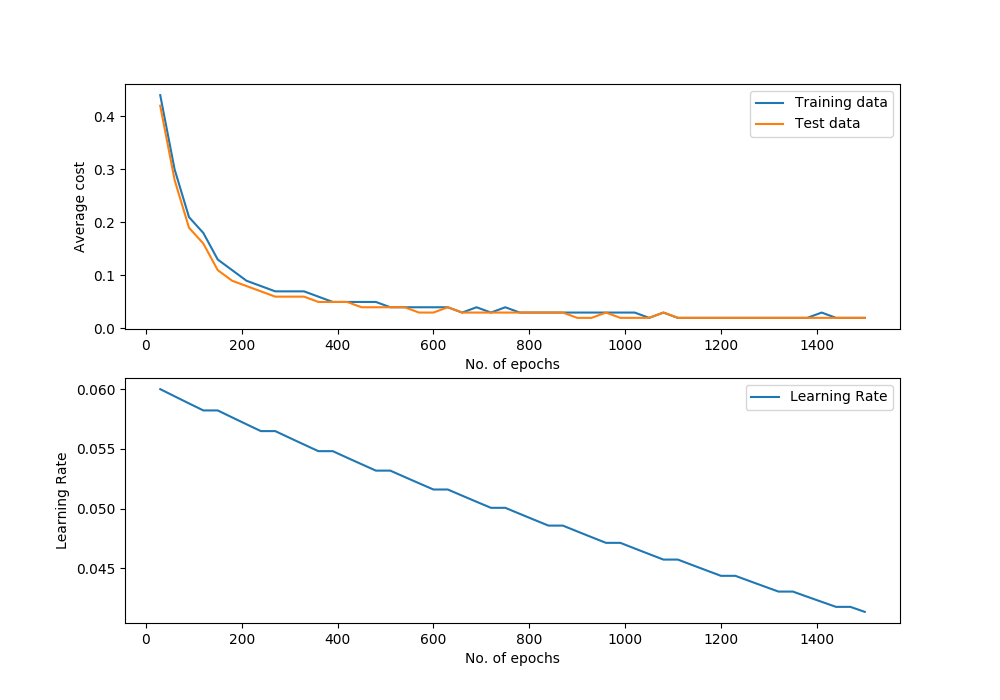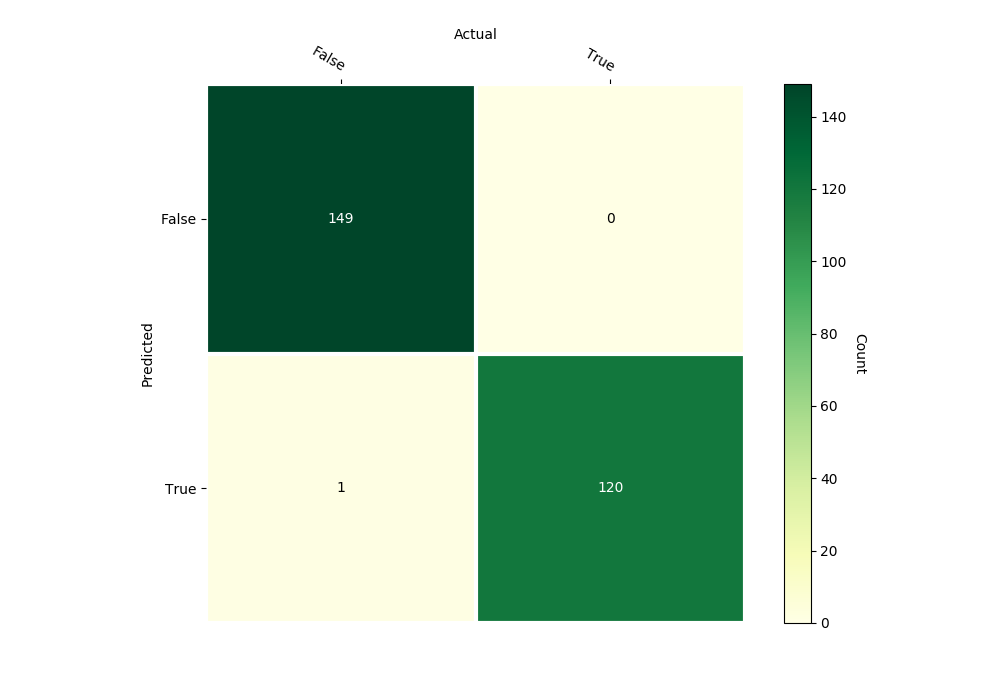Logistic Regression¶
Class Reference¶
-
class
pykitml.LogisticRegression(input_size, output_size, reg_param=0)¶ Implements logistic regression for classification.
-
__init__(input_size, output_size, reg_param=0)¶ Parameters: - input_size (int) – Size of input data or number of input features.
- output_size (int) – Number of categories or groups.
- reg_param (int) – Regularization parameter for the model, also known as ‘weight decay’.
-
feed(input_data)¶ Accepts input array and feeds it to the model.
Parameters: input_data (numpy.array) – The input to feed the model. Raises: ValueError– If the input data has invalid dimensions/shape.Note
This function only feeds the input data, to get the output after calling this function use
get_output()orget_output_onehot()
-
get_output()¶ Returns the output activations of the model.
Returns: The output activations. Return type: numpy.array
-
get_output_onehot()¶ Returns the output layer activations of the model as a one-hot array. A one-hot array is an array of bits in which only one of the bits is high/true. In this case, the corresponding bit to the neuron/node having the highest activation will be high/true.
Returns: The one-hot output activations array. Return type: numpy.array
-
train(training_data, targets, batch_size, epochs, optimizer, testing_data=None, testing_targets=None, testing_freq=1, decay_freq=1)¶ Trains the model on the training data, after training is complete, you can call
plot_performance()to plot performance graphs.Parameters: - training_data (numpy.array) – numpy array containing training data.
- targets (numpy.array) – numpy array containing training targets, corresponding to the training data.
- batch_size (int) – Number of training examples to use in one epoch, or number of training examples to use to estimate the gradient.
- epochs (int) – Number of epochs the model should be trained for.
- optimizer (any Optimizer object) – See Optimizers
- testing_data (numpy.array) – numpy array containing testing data.
- testing_targets (numpy.array) – numpy array containing testing targets, corresponding to the testing data.
- testing_freq (int) – How frequently the model should be tested, i.e the model will be tested
after every
testing_freqepochs. You may want to increase this to reduce training time. - decay_freq (int) – How frequently the model should decay the learning rate. The learning rate
will decay after every
decay_freqepochs.
Raises: ValueError– Iftraining_data,targets,testing_dataortesting_targetshas invalid dimensions/shape.
-
plot_performance()¶ Plots logged performance data after training. Should be called after
train().Raises:
-
cost(testing_data, testing_targets)¶ Tests the average cost of the model on the testing data passed to the function.
Parameters: - testing_data (numpy.array) – numpy array containing testing data.
- testing_targets (numpy.array) – numpy array containing testing targets, corresponding to the testing data.
Returns: cost – The average cost of the model over the testing data.
Return type: float
Raises: ValueError– Iftesting_dataortesting_targetshas invalid dimensions/shape.
-
accuracy(testing_data, testing_targets)¶ Tests the accuracy of the model on the testing data passed to the function. This function should be only used for classification.
Parameters: - testing_data (numpy.array) – numpy array containing testing data.
- testing_targets (numpy.array) – numpy array containing testing targets, corresponding to the testing data.
Returns: accuracy – The accuracy of the model over the testing data i.e how many testing examples did the model predict correctly.
Return type: float
-
confusion_matrix(test_data, test_targets, gnames=[], plot=True)¶ Returns and plots confusion matrix on the given test data.
Parameters: - test_data (numpy.array) – Numpy array containing test data
- test_targets (numpy.array) – Numpy array containing the targets corresponding to the test data.
- plot (bool) – If set to false, will not plot the matrix. Default is true.
- gnames (list) – List of string names for each class/group.
Returns: confusion_matrix – The confusion matrix.
Return type: numpy.array
-
Example: Banknote Authentication¶
Dataset
Banknote - pykitml.datasets.banknote module
Training
import os.path
import pykitml as pk
from pykitml.datasets import banknote
# Download the dataset
if not os.path.exists('banknote.pkl'):
banknote.get()
# Load banknote data set
inputs_train, outputs_train, inputs_test, outputs_test = banknote.load()
# Normalize dataset
array_min, array_max = pk.get_minmax(inputs_train)
inputs_train = pk.normalize_minmax(inputs_train, array_min, array_max)
inputs_test = pk.normalize_minmax(inputs_test, array_min, array_max)
# Create polynomial features
inputs_train_poly = pk.polynomial(inputs_train)
inputs_test_poly = pk.polynomial(inputs_test)
# Create model
banknote_classifier = pk.LogisticRegression(inputs_train_poly.shape[1], 1)
# Train the model
banknote_classifier.train(
training_data=inputs_train_poly,
targets=outputs_train,
batch_size=10,
epochs=1500,
optimizer=pk.Adam(learning_rate=0.06, decay_rate=0.99),
testing_data=inputs_test_poly,
testing_targets=outputs_test,
testing_freq=30,
decay_freq=40
)
# Save it
pk.save(banknote_classifier, 'banknote_classifier.pkl')
# Plot performance
banknote_classifier.plot_performance()
# Print accuracy
accuracy = banknote_classifier.accuracy(inputs_train_poly, outputs_train)
print('Train accuracy:', accuracy)
accuracy = banknote_classifier.accuracy(inputs_test_poly, outputs_test)
print('Test accuracy:', accuracy)
# Plot confusion matrix
banknote_classifier.confusion_matrix(inputs_test_poly, outputs_test)
Predict banknote validity with variance, skewness, curtosis, entropy: -2.3, -9.3, 9.37, -0.86
import numpy as np
import pykitml as pk
from pykitml.datasets import banknote
# Predict banknote validity with variance, skewness, curtosis, entropy
# of -2.3, -9.3, 9.37, -0.86
# Load banknote data set
inputs_train, _, _, _ = banknote.load()
# Load the model
banknote_classifier = pk.load('banknote_classifier.pkl')
# Normalize the inputs
array_min, array_max = pk.get_minmax(inputs_train)
input_data = pk.normalize_minmax(np.array([-2.3, -9.3, 9.37, -0.86]), array_min, array_max)
# Create polynomial features
input_data_poly = pk.polynomial(input_data)
# Get output
banknote_classifier.feed(input_data_poly)
model_output = banknote_classifier.get_output()
# Print result
print(model_output)
Performance Graph

Confusion Matrix
